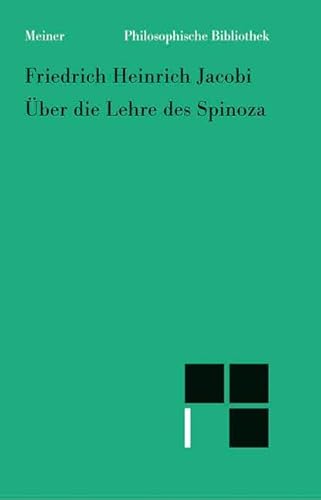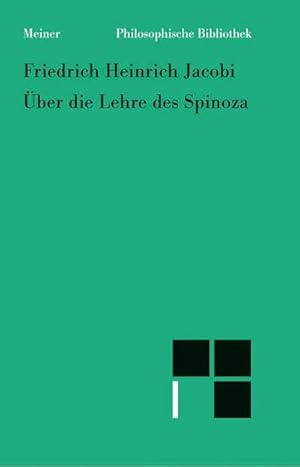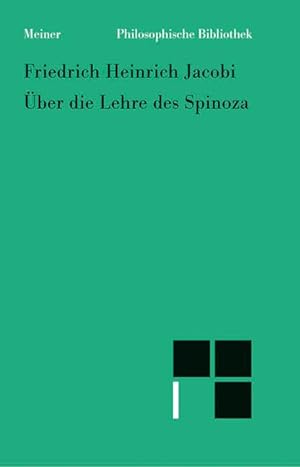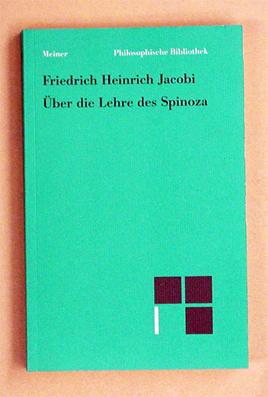Ueber die Lehre des Spinoza Briefen den Herrn Moses Mendelssohn (9 Ergebnisse)
Produktart
- Alle Produktarten
- Bücher (9)
- Magazine & Zeitschriften
- Comics
- Noten
- Kunst, Grafik & Poster
- Fotografien
- Karten
-
Manuskripte &
Papierantiquitäten
Zustand
Einband
Weitere Eigenschaften
- Erstausgabe (1)
- Signiert (1)
- Schutzumschlag
- Angebotsfoto (5)
Land des Verkäufers
Verkäuferbewertung
-
UEBER DIE LEHRE DES SPINOZA IN BRIEFEN AN DEN HERRN MOSES MENDELSSOHN
Anbieter: Schmidt Periodicals GmbH, Bad Feilnbach, Deutschland
Buch
Bound. 1 volume. Breslau, 1785. Reprint.
-
Breslau, Löwe, 1785. 8vo. Nice contemporary half calf with five raised bands, gilt lines, and gilt title-label to spine. A bit of wear to extremities. Internally very nice and clean. Printed on good paper. A stamp to title-page (Holsteinborg). Inscribed by the author on front free end-paper. (8)215, (1, - errata) pp. A magnificent presentation-copy of the rare first edition, first issue (with the "S. das Gedicht am Ende des Briefes"-note on p. 11) of this milestone of 18th century thought, one of the most scandalous books of its time, the work that reintroduced Spinoza to a society otherwise dominated by French Enlightenment thinking, and the work that begain the famous "Pantheismusstreit", one of the most important feuds in German philosophy. Presentation-copies by Jacobi are of the utmost scarcity and hardly ever come on the market. The present copy bears a two-line inscription to the famous physician Philipp Hensler, signed "The Author", on the front free end-paper: "Seinem verehrtesten Gönner und lieben/ Freunde, dem Herrn Hensler in Altona/ Der Verfasser". The city of Altona plays a significant role in late 18th century German thought, as many of the most important thinkers of the period pass through there. In the late 18th century, Altona developed into the centre of Enlightenment in Northern Germany. It is here that Jacobi meets Hensel, who comes to play an important role in his life, as is also evident from the present inscription ("honoured benefactor and dear friend"). Philipp Gabriel Hensler (1733-1805) was a famous German doctor, an outstanding physician, who is still famous today for his pioneering work in hygiene statistics and in pox-inoculation. He was so famous in his time that for a time he was the preferred choice for the position of private doctor to the Danish King Christian VII, right up until that historical moment when Struensee was chosen instead. When Struensee was given the position, Hensler was given Struensee's old position as physician in Altona. With the first edition of "Ueber die Lehre des Spinoza" (1785), Jacobi begins the famous "PATHEISMUSSTREIT", which focused attention on the apparent conflict between human freedom and any systematic, philosophical interpretation of reality. In 1780, Jacobi (1743-1819), famous for coining the term nihilism, advocating "belief" and "revelation" instead of speculative reason, thereby anticipating much of present-day literature, and for his critique of the Sturm-und-Drang-era, had a conversation with Lessing, in which Lessing stated that the only true philosophy was Spinozism. This led Jacobi to a protracted and serious study of Spinoza's works. After Lessing's death, in 1783 Jacobi began a lengthy letter-correspondende with Mendelssohn, a close friend of Lessing, on the philosophy of Spinoza. These letters, with commentaries by Jacobi, are what constitute the first edition of "Ueber die lehre des Spinoza". The work caused great furor and the enmity of the Enlightenment thinkers. Jacobi was ridiculed by his contemporaries for attempting to reintroduce into philosophy belief instead of reason, was seen as an enemy of reason and Enlightenment, as a pietist, and as a Jesuit. But the publication of the work not only caused great furor in wider philosophical circles, there was also a personal side to the scandal which has made it one of the most debated books of the period: "Mendelssohn enjoyed, as noted at the outset, a lifelong friendship with G. E. Lessing. Along with Mendelssohn, Lessing embraced the idea of a purely rational religion and would endorse Mendelssohn's declaration: "My religion recognizes no obligation to resolve doubt other than through rational means" and it commands no mere faith in eternal truths" (Gesammelte Schriften, Volume 3/2, p. 205). To pietists of the day, such declarations were scandalous subterfuges of an Enlightenment project of assimilating religion to natural reason. While Mendelssohn skillfully avoided that confrontation, he found himself reluctantly unable to remain silent when, after Lessing's death, F. H. Jacobi contended that Lessing embraced Spinoza's pantheism and thus exemplified the Enlightenment's supposedly inevitable descent into irreligion.Following private correspondence with Jacobi on the issue and an extended period when Jacobi (in personal straits at the time) did not respond to his objections, Mendelssohn attempted to set the record straight about Lessing's Spinozism in "Morning Hours". Learning of Mendelssohn's plans incensed Jacobi who expected to be consulted first and who accordingly responded by publishing, without Mendelssohn's consent, their correspondence - "On the Teaching of Spinoza in Letters to Mr. Moses Mendelssohn" - a month before the publication of "Morning Hours". Distressed on personal as well as intellectual levels by the controversy over his departed friend's pantheism, Mendelssohn countered with a hastily composed piece, "To the Friends of Lessing: an Appendix to Mr. Jacobi's Correspondence on the Teaching of Spinoza". According to legend, so anxious was Mendelssohn to get the manuscript to the publisher that, forgetting his overcoat on a bitterly cold New Year's eve, he delivered the manuscript on foot to the publisher. That night he came down with a cold from which he died four days later, prompting his friends to charge Jacobi with responsibility for Mendelssohn's death.The sensationalist character of the controversy should not obscure the substance and importance of Mendelssohn's debate with Jacobi. Jacobi had contended that Spinozism is the only consistent position for a metaphysics based upon reason alone and that the only solution to this metaphysics so detrimental to religion and morality is a leap of faith, that salto mortale that poor Lessing famously refused to make. Mendelssohn counters Jacobi's first contention by attempting to demonstrate the metaphysical inconsistency of Spinozism. He takes aim at Jacobi's second contention by demonstrat.
-
Breslau, Gottl. Löwe, 1789, 8vo. Very beautiful contemporary red full calf binding with five raised bands and gilt green leather title-label to richly gilt spine. elaborate gilt borders to boards, inside which a "frame" made up of gilt dots, with giltcorner-ornamentations. Edges of boards gilt and inner gilt dentelles. All edges gilt. Minor light brownspotting. Marginal staining to the last leaves. Engraved frontispiece-portrait of Spinoza, engraved title-vignette (double-portrait, of Lessing and Mendelssohn), engraved end-vignette (portrait of Jacobi). Frontispiece, title-page, LI, (1, -errata), 440 pp. Magnificent copy. First edition thus, being the seminal second edition, the "neue vermehrte Auflage" (new and expanded edition), which has the hugely important 180 pp. of "Beylage" for the first time, which include the first translation into any language of any part of Giordano Bruno's "de Uno et Causa." (pp. 261-306) as well as several other pieces of great importance to the "Pantheismusstreit" and to the interpretation of the philosophy of Spinoza and Leibniz, here for the first time in print. The present translation of Bruno seems to be the earliest translation of any of Bruno's works into German, and one of the earliest translations of Bruno at all - as far as we can establish, the second, only preceded by an 18th century translation into English of "Spaccio della bestia trionfante". It is with the present edition of Jacobi's work that the interest in Bruno is founded and with which Bruno is properly introduced to the modern world. Jacobi not only provides what is supposedly the second earliest translation of any of Bruno's works ever to appear, he also establishes the great influence that Bruno had on two of our greatest thinkers, Spinoza and Leibnitz. It is now generally accepted that Spinoza founds his ethical thought upon Bruno and that Lebnitz has taken his concept of the "Monads" from him. It is Jacobi who, with the second edition of his "Letters on Spinoza.", for the first time ever puts Bruno where he belongs and establishes his position as one of the key figures of modern philosophy and thought. Bruno's works, the first editions of which are all of the utmost scarcity, were not reprinted in their time, and new editions of them did not begin appearing until the 19th century. For three centuries his works had been hidden away in libraries, where only few people had access to them. Thus, as important as his teachings were, thinkers of the ages to come were largely reliant on more or less reliable renderings and reproductions of his thoughts. As Jacobi states in the preface to the second edition of his "Letters on Spinoza.", "There appears in this new edition, under the title of Appendices ("Beylage"), different essays, of which I will here first give an account. The first Appendix is an excerpt from the extremely rare book "De la causa, principio, et Uno", by Jordan Bruno. This strange man was born, one knows not in which year, in Nola, in the Kingdom of Naples" and died on February 17th 1600 in Rome on the stake. With great diligence Brucker has been gathering information on him, but in spite of that has only been able to deliver fragments [not in translation]. For a long time his works were, partly neglected due to their obscurity, partly not respected due to the prejudice against the new opinions and thoughts expressed in them, and partly loathed and suppressed due to the dangerous teachings they could contain. On these grounds, the current scarcity of his works is easily understood. Brucker could only get to see the work "De Minimo", La Croce only had the book "De Immenso et Innumerabilibus" in front of him, or at least he only provides excerpts from this [also not in translation], as Heumann does only from the "Physical Theorems" [also small fragments, not in translation]" also Bayle had, of Bruno's metaphysical works, himself also merely read this work, of which I here provide an excerpt." (Vorrede, pp. (VII)-VIII - own translation from the German). Jacobi continues by stating that although everyone complains about the obscurity of Bruno's teachings and thoughts, some of the greatest thinkers, such as Gassendi, Descartes, "and our own Leibnitz" (p. IX) have taken important parts of their theorems and teachings from him. "I will not discuss this further, and will merely state as to the great obscurity ("grossen Dunkelheit") of which people accuse Bruno, that I have found this in neither his book "de la Causa" nor in "De l'Infinito Universo et Mondi", of which I will speak implicitly on another occasion. As to the first book, my readers will be able to judge for themselves from the sample ("Probe") that I here present. My excerpt can have become a bit more comprehensible due to the fact that I have only presented the System of Bruno himself, the "Philosophia Nolana" which he himself calls it, in its continuity. My main purpose with this excerpt is, by uniting Bruno with Spinoza, at the same time to show and explain the "Summa of Philosophy" ("Summa der Philosophie") of "En kai Pan" [in Greek characters - meaning "One and All"]. . It is very difficult to outline "Pantheism" in its broader sense more purely and more beautifully than Bruno has done." (Vorrede pp. IX-XI - own translation from the German). So not only does Jacobi here provide this groundbreaking piece of Bruno's philosophy in the first translation ever, and not only does he provide one of the most important interpretations of Spinoza's philosophy and establishes the importance of Bruno to much of modern thought, he also presents Bruno as the primary exponent of "pantheism", thereby using Bruno to change the trajectory of modern thought and influencing all philosophy of the decades to come. After the second edition of Jacobi's "Ueber die Lehre des Spinoza", no self-respecting thinker could neglect the teachings of Bruno" he could no longer be written off as having "obscure" and insignificant teachings, and one co.
-
Über die Lehre des Spinoza in Briefen an den Herrn Moses Mendelssohn
Verlag: Meiner Felix Verlag GmbH, 2005
ISBN 10: 3787317066ISBN 13: 9783787317066
Anbieter: Blackwell's, London, Vereinigtes Königreich
Buch
paperback. Zustand: New. Language: ger.
-
Über die Lehre des Spinoza in Briefen an den Herrn Moses Mendelssohn
Verlag: Meiner Felix Verlag Gmbh Jan 2004, 2004
ISBN 10: 3787317066ISBN 13: 9783787317066
Anbieter: AHA-BUCH GmbH, Einbeck, Deutschland
Buch
Taschenbuch. Zustand: Neu. Neuware - Die Schrift »Über die Lehre des Spinoza in Briefen an den Herrn Moses Mendelssohn« (1785) dokumentiert und reflektiert das berühmte Gespräch zwischen Lessing und Jacobi vom Juli 1780, in dem Lessing sich zum Pantheismus Spinozas bekannte. Das von Jacobi überlieferte Bekenntnis bildet den Ausgangspunkt für den Spinozastreit - zunächst in Briefen ausgetragen zwischen Friedrich Heinrich Jacobi und Moses Mendelssohn.Die Auswirkungen des Spinozastreites auf die Entwicklung der Philosophiegeschichte sind kaum zu ermessen. Er markiert die Wende von der Aufklärung zur Romantik und zum Deutschen Idealismus.Die vorliegende Studienausgabe basiert auf der historisch-kritischen Ausgabe Friedrich Heinrich Jacobi. Werke. Band 1. Wiedergegeben werden der Text Über die Lehre des Spinoza in den Briefen an Herrn Moses Mendelssohn (1785), die Erweiterungen der zweiten Auflage (1789) und der Vorbericht der dritten Auflage aus dem vierten Band der Werke Friedrich Heinrich Jacobis (1819) in orthographisch behutsam modernisierter Form. Der Anmerkungsteil gibt Erläuterungen zu Personen und bibliographische Angaben.
-
Über die Lehre des Spinoza in Briefen an den Herrn Moses Mendelssohn
Verlag: Meiner, 2005
ISBN 10: 3787317066ISBN 13: 9783787317066
Anbieter: moluna, Greven, Deutschland
Buch
Zustand: New.
-
Über die Lehre des Spinoza in Briefen an den Herrn Moses Mendelssohn. Auf der Grundlage der Ausgabe von Klaus Hammacher und Irmgard-Maria Piske bearbeitet von Marion Lauschke.
Verlag: Hamburg, Meiner, 2000
Anbieter: antiquariat peter petrej - Bibliopolium AG, Zürich, ZH, Schweiz
8°, XI, 374 S., Brosch., Tadellos. (= Philosophische Bibliothek, Bd. 517). 900 gr. Schlagworte: Philosophie.
-
Werke. Hrsg. von Friedrich Roth und Friedrich Köppen. Vierter Band. Erste und zweite Abteilung. Vorbericht. Über die Lehre des Spinoza, in Briefen an Herrn Moses Mendelssohn. Beilagen zu den Briefen über die Lehre Spinozas. Wider Mendelssohns Beschuldigungen in dessen Schreiben an die Freunde Lessing. Nachdruck der Ausgabe.
Verlag: Wissenschaftliche Buchgesellschaft Darmstadt,, 1968
Anbieter: Bernhard Kiewel Rare Books, Grünberg, Deutschland
Buch
19 x 13. Reprografischer Nachdruck der Ausgabe Leipzig. 253, 276 Seiten. Brauner OLeinen mit Goldprägung. Ordnungsgemäß aus einer Universitäts-Bibliothek ausgesondert (Stempel, Signatur). Gut erhaltenes Exemplar. Sprache: Deutsch Gewicht in Gramm: 469.
-
Werke. Herausgegeben von Friedrich Roth und Friedrich Köppen. Vierter (4.) Band, 1. und 2. Abteilung: Vorbericht. Über die Lehre des Spinoza, in Briefen an Herrn Moses Mendelssohn. Beilagen zu den Briefen über die Lehre Spinozas. Wider Mendelssohns Beschuldigungen in dessen Schreiben an die Freunde Lessing. Nachdruck der Ausgabe Leipzig 1819
Verlag: Darmstadt, Wissenschaftliche Buchgesellschaft, 1976., 1976
Anbieter: Antiquariat FOLIO Karpinski u. Gaukesbrink GbR, Münster, Deutschland
253,276 S. Originalleinen (Hardcover). Kleiner Fleck auf dem Rücken, kleiner Adressaufkleber auf Innendeckel, sonst sauber und gut. Sprache: de.



![Bild des Verkäufers für Ueber die Lehre des Spinoza in Briefen an den Herrn Moses Mendelssohn. - [INITIATING THE PANTHEISMUSSTREIT - PRESENTATION-COPY] zum Verkauf von Lynge & Søn ILAB-ABF](https://pictures.abebooks.com/inventory/md/md17146590580.jpg)
![Bild des Verkäufers für Ueber die Lehre des Spinoza in Briefen an den Herrn Moses Mendelssohn. Neue vermehrte Auflage. - [THE FIRST EVER TRANSLATION OF BRUNO'S "DE UNO ET CAUSA".] zum Verkauf von Lynge & Søn ILAB-ABF](https://pictures.abebooks.com/inventory/md/md7030248925.jpg)



